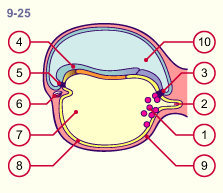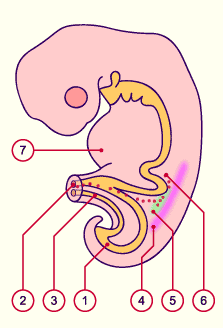|

|
|
|
3.1 The germline - origin of the germ cells
|
|
|
|
The primordial germ cells are the common origins of spermatozoa and oocytes and thus represent the ancestors of the germline. Like all other somatic cells these are diploid and in human embryos can already be found in the primary ectoderm (epiblast) in the second week.
|
|
|
Emigration of the germ cells
|
|
|
| In the third week, the primordial germ cells wander - in an amoeboid manner - from the primary ectoderm into the yolk sac wall and collect near the exit of the allantois. The primordial germ cells are now extraembryonal, lying in the endoderm and mesoderm of the yolk sac wall. |
|
Fig. 3 - Embryo in the 4th week |
|
Legend |
|

1
2
3
4
5
6
7
8
9
10 |
Primordial germ cells
Allantois
Rectum
Ectoderm
Foregut
Primordial heart
Secondary yolk sac
Endoderm (yellow)
Mesoderm (red)
Amniotic cavity |
|
|
|
Fig. 3
Having emigrated from the ectoderm, the primordial germ cells are now situated among the endoderm cells in the secondary yolk sac wall.
|
| Facilitated through the cranio-caudal curvature and the lateral folding of the embryo, the primordial germ cells wander back into the embryo again between the fourth and sixth week. They move along the yolk sac wall to the vitelline and into the wall of the rectum. After crossing the dorsal mesentery they colonize the gonadal ridge. During their journey, but also while still in the gonadal ridge, the primordial germ cells multiply by mitotic divisions. Figure 4 provides a view of this journey. On the next page, a more detailed prospect is shown in figure 5. |
|
Fig. 4 - Embryo in the 5th week |
|
Legend |
|

1
2
3
4
5
6
7
|
Rectum
Vitelline
Allantois
Nephrogenic cord (pink)
Gonadal ridge (green)
Primordial germ cells (red dots)
Heart prominence |
|
|
|
Fig. 4
The primordial germ cells wander out of the yolk sac wall, along the vitelline and the dorsal mesentery, into the gonadal ridge. They reach this structure in the 6th week.
|
|
|